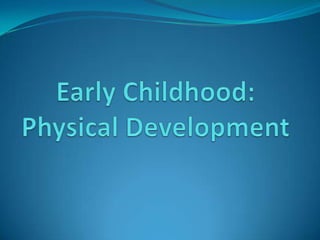Early childhood
•Download as PPTX, PDF•
1 like•1,451 views
Report
Share
Report
Share

Recommended
More Related Content
What's hot
What's hot (20)
Viewers also liked
Viewers also liked (20)
Activities and materials to encourage aesthetic development through

Activities and materials to encourage aesthetic development through
Physical Development of Preschoolers by NJA BSED - Biology

Physical Development of Preschoolers by NJA BSED - Biology
Development psychology (Physical and Cognitive Development in Early Childhood)

Development psychology (Physical and Cognitive Development in Early Childhood)
Ages & stages of 3 4 year old social development rev2

Ages & stages of 3 4 year old social development rev2
Cognitive development including piaget's theory(mainly in pre-school years)

Cognitive development including piaget's theory(mainly in pre-school years)
Socio emotional development of infants and toddlers

Socio emotional development of infants and toddlers
Similar to Early childhood
Similar to Early childhood (20)
Physical and motor development of children and adolescents

Physical and motor development of children and adolescents
Lifespan Psychology Lecture, Chapter 2, Module 2.1

Lifespan Psychology Lecture, Chapter 2, Module 2.1
Recently uploaded
Recently uploaded (20)
HMCS Vancouver Pre-Deployment Brief - May 2024 (Web Version).pptx

HMCS Vancouver Pre-Deployment Brief - May 2024 (Web Version).pptx
Python Notes for mca i year students osmania university.docx

Python Notes for mca i year students osmania university.docx
UGC NET Paper 1 Mathematical Reasoning & Aptitude.pdf

UGC NET Paper 1 Mathematical Reasoning & Aptitude.pdf
Micro-Scholarship, What it is, How can it help me.pdf

Micro-Scholarship, What it is, How can it help me.pdf
Food safety_Challenges food safety laboratories_.pdf

Food safety_Challenges food safety laboratories_.pdf
Basic Civil Engineering first year Notes- Chapter 4 Building.pptx

Basic Civil Engineering first year Notes- Chapter 4 Building.pptx
On National Teacher Day, meet the 2024-25 Kenan Fellows

On National Teacher Day, meet the 2024-25 Kenan Fellows
Kodo Millet PPT made by Ghanshyam bairwa college of Agriculture kumher bhara...

Kodo Millet PPT made by Ghanshyam bairwa college of Agriculture kumher bhara...
Salient Features of India constitution especially power and functions

Salient Features of India constitution especially power and functions
General Principles of Intellectual Property: Concepts of Intellectual Proper...

General Principles of Intellectual Property: Concepts of Intellectual Proper...
This PowerPoint helps students to consider the concept of infinity.

This PowerPoint helps students to consider the concept of infinity.
ICT role in 21st century education and it's challenges.

ICT role in 21st century education and it's challenges.
Early childhood
- 2. Ages 2 - 6 are the early childhood years, or preschool years. Although physical development in preschoolers is slower and more stable than during infancy.
- 3. Some important influences on physical Development during the preschool period : Physical Changes Brain Development Motor Skills Health
- 4. Physical Changes Children begin to lose their baby fat around age 3. Toddlers soon acquire the leaner, more athletic look associated with childhood. The child's trunk and limbs grow longer, and the abdominal muscles form, tightening the appearance of the stomach. Boys tend to have more muscle mass than girls. The preschoolers' physical proportions also continue to change.
- 5. Three-year-old preschoolers may grow to be about 38 inches tall and weigh about 32 pounds. For the next 3 years, healthy preschoolers grow an additional 2 to 3 inches and gain from 4 to 6 pounds per year. By age 6, children reach a height of about 46 inches and weigh about 46 pounds.
- 6. Brain Development The two cerebral hemispheres develop at different rates, with the left hemisphere developing more fully in early childhood (ages 2 to 6), and the right hemisphere developing more fully in middle childhood (ages 7 to 11).
- 7. Handedness - preference for using one hand over the other. 90 percent of the general population is right-handed, while the rest of the population is left-handed and/or ambidextrous. A person is ambidextrous if he or she shows no preference for one hand over the other.
- 8. The nervous system undergoes changes in early childhood too. The majority of a child's neurons, glial cells and myelin sheaths form prenatally and develop most rapidly. Neurons - cells that make up nerves Glial cells - (nervous system support cells surrounding neurons) that nourish, insulate, and remove waste from the neurons without actually transmitting information themselves The myelin sheaths - surround, insulate, and increase the efficiency of neurons (by speeding up the action potential along the axon)
- 9. Motor Skills Gross motor skills - involve the use of large bodily movements. Fine motor skills - involve the use of small bodily movements. fine motor skills develop more slowly in preschoolers.
- 10. Albert Bandura's theory of Observational Learning 1. Observe the behavior in others. 2. Form a mental image of the behavior. 3. Imitate the behavior. 4. Practice the behavior. 5. Be motivated to repeat the behavior.
- 11. Health minor illnesses - last no more than 14 days may help children to learn coping skills. may also help children learn empathy. major illnesses - last longer than 14 days Respiratory ailments are the most common illnesses among children at this age because preschoolers' lungs have not yet fully developed.
- 12. The majority of deaths during early childhood are due to accidental injuries rather than illnesses. The most common causes of childhood death the automobile Other causes of childhood death Drowning Suffocating being burned being poisoned falling from heights Young children's sense of adventure often outweighs their understanding of the dangers inherent in various activities and situations.
- 13. THANK YOU